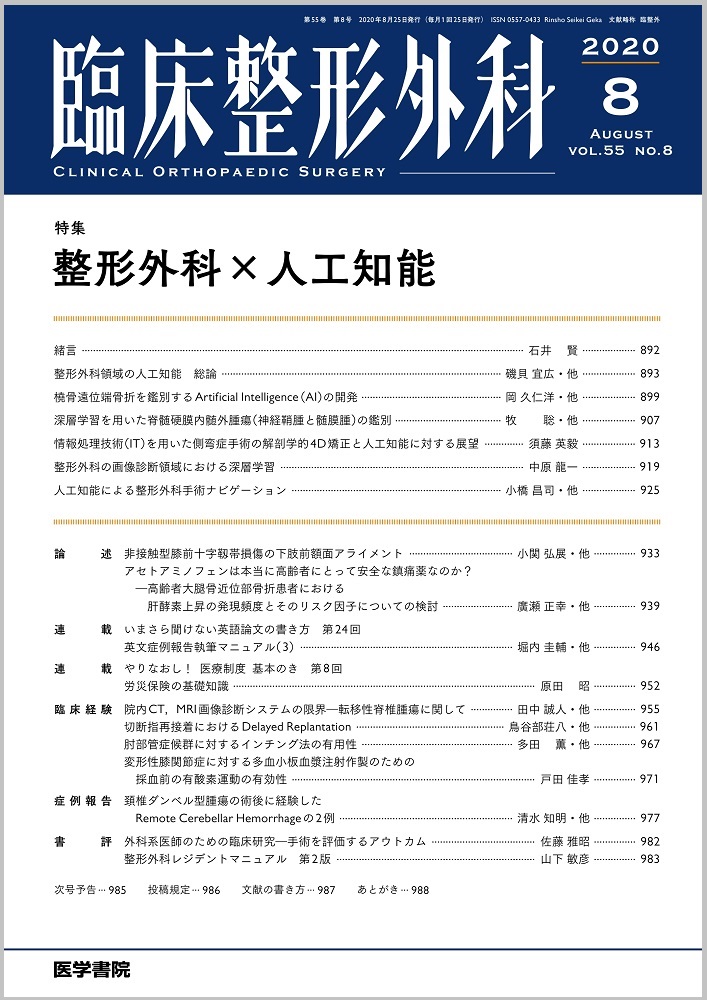1) 加藤有紀.前十字靱帯損傷の臨床.日大医誌2013;72(2):81-5.
2) Arendt E, Dick R. Knee injury patterns among men and women in collegiate basketball and soccer. NCAA data and review of literature. Am J Sports Med 1995;23(6):694-701.
3) 古賀英之,宗田 大.膝前十字靱帯損傷の受傷メカニズム.関節外科2015;34(3):234-41.
4) Lee DY, Karim SA, Chang HC. Return to sports after anterior cruciate ligament reconstruction - a review of patients with minimum 5-year follow-up. Ann Acad Med Singapore 2008;37(4):273-8.
5) Gobbi A, Francisco R. Factors affecting return to sports after anterior cruciate ligament reconstruction with patellar tendon and hamstring graft:a prospective clinical investigation. Knee Surg Sports Traumatol Arthrosc 2006;14(10):1021-8.
6) Dragoo JL, Braun HJ, Durham JL, et al. Incidence and risk factors for injuries to the anterior cruciate ligament in National Collegiate Athletic Association football:data from the 2004-2005 through 2008-2009 National Collegiate Athletic Association Injury Surveillance System. Am J Sports Med 2012;40(5):990-5.
7) Griffin LY, Albohm MJ, Arendt EA, et al. Understanding and preventing noncontact anterior cruciate ligament injuries:a review of the Hunt Valley II meeting, January 2005. Am J Sports Med 2006;34(9):1512-32.
8) Myer GD, Ford KR, Paterno MV, et al. The effects of generalized joint laxity on risk of anterior cruciate ligament injury in young female athletes. Am J Sports Med 2008;36(6):1073-80.
9) Ramesh R, Von Arx O, Azzopardi T, et al. The risk of anterior cruciate ligament rupture with generalised joint laxity. J Bone Joint Surg Br 2005;87(6):800-3.
10) Beynnon BD, Johnson RJ, Braun S, et al. The relationship between menstrual cycle phase and anterior cruciate ligament injury:a case-control study of recreational alpine skiers. Am J Sports Med 2006;34(5):757-64.
11) Bayer S, Meredith SJ, Wilson K, et al. Knee morphological risk factors for anterior cruciate ligament injury:a systematic review. J Bone Joint Surg Am 2020;102(8):703-18.
12) Shambaugh JP, Klein A, Herbert JH. Structural measures as predictors of injury basketball players. Med Sci Sports Exerc 1991;23(5):522-7.
13) Kramer LC, Denegar CR, Buckley WE, et al. Factors associated with anterior cruciate ligament injury:history in female athletes. J Sports Med Phys Fitness 2007;47(4):446-54.
14) Loudon JK, Jenkins W, Loudon KL. The relationship between static posture and ACL injury in female athletes. J Orthop Sports Phys Ther 1996;24(2):91-7.
15) Hertel J, Dorfman JH, Braham RA. Lower extremity malalignments and anterior cruciate ligament injury history. J Sports Sci Med 2004;3(4):220-5.
16) Kızılgöz V, Sivrioğlu AK, Ulusoy GR, et al. Analysis of the risk factors for anterior cruciate ligament injury:an investigation of structural tendencies. Clin Imaging 2018;50:20-30.
17) Miljko M, Grle M, Kozul S, et al. Intercondylar notch width and inner angle of lateral femoral condyle as the risk factors for anterior cruciate ligament injury in female handball players in Herzegovina. Coll Antropol 2012;36(1):195-200.
18) Gray J, Taunton JE, McKenzie DC, et al. A survey of injuries to the anterior cruciate ligament of the knee in female basketball players. Int J Sports Med 1985;6(6):314-6.
19) Nakano N, Matsumoto T, Hashimura M, et al. Coronal lower limb alignment in normal knees--a radiographic analysis of 797 normal knee subjects. Knee 2016;23(2):209-13.
20) Siu D, Cooke TD, Broekhoven LD, et al. A standardized technique for lower limb radiography. Practice, applications, and error analysis. Invest Radiol 1991;26(1):71-7.
21) Cooke TD, Scudamore RA, Bryant JT, et al. A quantitative approach to radiography of the lower limb. Principles and applications. J Bone Joint Surg Br 1991;73(5):715-20.
22) Shrout PE, Fleiss JL. Intraclass correlations:uses in assessing rater reliability. Psychol Bull 1979;86(2):420-8.
23) Hovinga KR, Lerner AL. Anatomic variations between Japanese and Caucasian populations in the healthy young adult knee joint. J Orthop Res 2009;27(9):1191-6.
24) Tamari K, Tinley P, Briffa K, et al. Ethnic-, gender-, and age-related differences in femorotibial angle, femoral antetorsion, and tibiofibular torsion:cross-sectional study among healthy Japanese and Australian Caucasians. Clin Anat 2006;19(1):59-67.
25) 腰野富久.変形性膝関節症の病因,分類と臨床所見.リウマチ1985;25:191-203.
26) Tang WM, Zhu YH, Chiu KY. Axial alignment of the lower extremity in Chinese adults. J Bone Joint Surg Am 2000;82(11):1603-8.
27) Hewett TE, Myer GD, Ford KR, et al. Biomechanical measures of neuromuscular control and valgus loading of the knee predict anterior cruciate ligament injury risk in female athletes:a prospective study. Am J Sports Med 2005;33(4):492-501.
28) 小林寛和.膝関節における外傷発生の運動学的分析.女子バスケットボールにおける膝前十字靱帯損傷の発生機転を中心に.理学療法学1994;21(8):537-40.
29) Myer GD, Ford KR, Hewett TE. The effects of gender on quadriceps muscle activation strategies during a maneuver that mimics a high ACL injury risk position. J Electromyogr Kinesiol 2005;15(2):181-9.

